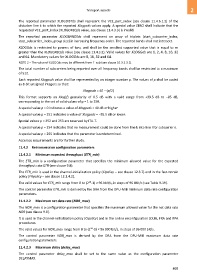Page 879 - 5G Basics - Core Network Aspects
P. 879
Transport aspects 2
The reported parameter XLOGDISTds shall represent the VCE_port_index (see clause 11.4.6.1.2) of the
disturber line k to which the reported Xlogpsds values apply. A special value ZERO shall indicate that the
requested VCE_port_index (XLOGDREQds value, see clause 11.4.3.3) is invalid.
The reported parameter XLOGBANDSds shall represent an array of triplets (start_subcarrier_index,
stop_subcarrier_index, group size) in increasing frequency order. The reported bands shall not intersect.
XLOGGds is restricted to powers of two, and shall be the smallest supported value that is equal to or
greater than the XLOGGREQds value (see clause 11.4.3.2). Valid values for XLOGGds are 1, 2, 4, 8, 16, 32
and 64. Mandatory values for XLOGGds are 8, 16, 32 and 64.
NOTE 2 – The value of XLOGGds may be different from F_sub (see clause 10.3.2.3.1).
The total number of subcarriers being reported over all frequency bands shall be restricted to a maximum
of 512.
Each reported Xlogpsds value shall be represented by an integer number p. The values of p shall be coded
as 8-bit unsigned integers so that:
Xlogpsds = 40 − (p/2)
This format supports an Xlog(f) granularity of 0.5 dB with a valid range from +39.5 dB to −85 dB,
corresponding to the set of valid values of p = 1 to 250.
A special value p = 0 indicates a value of Xlogpsds = 40 dB or higher
A special value p = 251 indicates a value of Xlogpsds = −85.5 dB or lower.
Special values p = 252 and 253 are reserved by ITU-T.
A special value p = 254 indicates that no measurement could be done from line k into line i for subcarrier n.
A special value p = 255 indicates that the parameter is undetermined.
Accuracy requirements are for further study.
11.4.2 Retransmission configuration parameters
11.4.2.1 Minimum expected throughput (ETR_min)
The ETR_min is a configuration parameter that specifies the minimum allowed value for the expected
throughput rate ETR (see clause 9.8).
The ETR_min is used in the channel-initialization policy (CIpolicy – see clause 12.3.7) and in the fast-retrain
policy (FRpolicy – see clause 12.1.4.2).
16
The valid values for ETR_min range from 0 to (2 -1) × 96 kbit/s, in steps of 96 kbit/s (see Table 9-19).
The control parameter ETR_min is derived by the DRA from the DPU-MIB minimum data rate configuration
parameters.
11.4.2.2 Maximum net data rate (NDR_max)
The NDR_max is a configuration parameter that specifies the maximum allowed value for the net data rate
NDR (see clause 9.8).
It is used in the channel-initialization policy (CIpolicy) and in the online reconfiguration (OLR), FRA and RPA
procedures.
16
The valid values for NDR_max range from 0 to (2 -1) × 96 000 bit/s, in steps of 96 000 bit/s.
The control parameter NDR_max is derived by the DRA from the DPU-MIB maximum data rate
configuration parameters.
11.4.2.3 Maximum delay (delay_max)
The control parameter delay_max shall be set to the same value as the configuration parameter
DELAYMAX.
869

